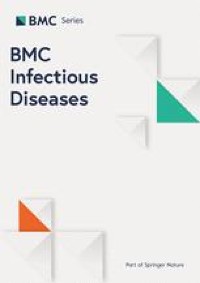Infection
Intestinal parasitic infections and their potential risk factors among prison inmates in Valencia, Spain
Prevalence of intestinal parasites among inmates of CPP, Valencia, Spain
The prevalence of infection reached 15.7% (83/528) in the total population studied (Table 1). Only protozoan, with a spectrum of six species, were detected. The most predominant species in the entire population of prisoners studied was the gut microeukaryotic potential pathobiont Blastocystis sp. (7.0%) (37/528). Moreover, among the group of 83 infected inmates, Blastocystis sp. infection appears with a frequency of 44.6% (37/83) and Giardia intestinalis with one of 12% (10/83).
Infections with a single species of protozoa (12.1%) (64/528) were more prevalent than co-infections (3.6%) (19/528), with statistically significant differences (p < 0.0001).
The prevalence of infection with pathogenic species (8.9%) (47/528) was similar to that of non-pathogenic species (8.7%) (46/528), and only 10 inmates (1.9%) (10/528) presented infections with both types of species.
Distribution of intestinal parasite infections among inmates by gender, age groups and according to intestinal symptoms
The distribution of intestinal parasite infections by gender, age groups and according to intestinal symptoms is presented in Table 2. A greater number of men, 471 (89.2%), were studied compared to women, 57 (10.8%). The prevalence of infection in men 15.2% (80/528) was higher than that of women 0.6% (3/528), with statistically significant differences (p = 0.021).
The frequency of infection among the group of males reached 16.9% (80/471), of whom 45 (56.3%) harbored pathogenic species. In contrast, the frequency of infection among the group of females was 5.3% (3/57), two (66.7%) of them harbored pathogenic species.
Inmates were distributed in four age groups: 18–24 years (4.5%); 25–34 years (21.8%); 35–44 years (36.2%); and ≥ 45 years (37.5%) (Table 2). No statistically significant difference in intestinal parasite prevalence was detected among the age groups (p = 0.143).
The age group ≥ 45 years showed the highest prevalence of infection of 6.3% (33/528), and the age group of 18–24 years was the least infected with intestinal parasites (0.8%) (4/528). Interestingly, the frequency of infection among the inmates in both age groups was similar (16.7% and 16.6%, respectively).
All age groups showed infections with pathogenic species, but they were most common in the age group of 35–44 years, of whom 14 (60.9%) inmates harbored pathogenic species.
Intestinal symptoms (abdominal pain and/or diarrhea) were reported by 11.3% (60/528) of inmates. Although intestinal parasites are thought to cause intestinal symptoms, the prevalence among those with intestinal symptomatology was low (1.7%) (9/528) (Table 2). We did not find an association between intestinal parasite infection and intestinal symptomatology, even reporting lower prevalence of infection than those who were asymptomatic (14.0%) (74/528). The bivariate analysis showed no association (p = 0.512) between intestinal parasite infection and intestinal symptoms (COR = 0.78, 95%CI = 0.32–1.67).
In those inmates reporting intestinal symptomatology the frequency of intestinal parasite infection was 15% (9/60). Moreover, of those nine infected who reported intestinal symptomatology, five (55.6%) inmates presented pathogenic species.
Intestinal parasite infections and potential risk factors
The socio-demographic characteristics considered as potential risk factors were education level, country of birth, time spent in prison, and a recent prison exit permit (Table 2).
Inmates with a low level of education (primary school or less) had similar prevalence of intestinal parasites as those with a higher level of education (secondary school or higher) (7.9% (42/528) and 7.8% (41/528), respectively). No association (p = 0.079) between presence of intestinal parasite and level of education was found in the bivariate analysis (COR = 0.65, 95%CI = 0.39–1.08).
Spanish inmates’ intestinal parasite prevalence was 8.9% (47/528), higher than those observed in inmates from other nationalities (6.8%) (36/528). More concretely, from the 120 foreigners, infection affected 15.8% South-Americans (19/120), 9% Europeans (11/120), 4.2% Africans (5/120) and 0.8% Asians (1/120). A statistically significant association (p = 0.003) between presence of intestinal parasite and country of birth was found in the bivariate analysis (COR = 0.42, 95% CI = 0.23–0.78).
The majority of the inmates who stayed in prison for 2 years or less had higher prevalence of infection (11.7%) (62/528) compared to those who stayed longer (4.0%) (21/528). Moreover, the bivariate analysis showed the difference in intestinal parasite infection with the time spent in prison was statistically significant (p = 0.013), and inmates who had spent 2 years or less in prison have a higher risk of intestinal parasites infection (COR = 1.93, 95%CI = 1.11–3.45).
Those who have not enjoyed a recent prison exit permit had higher prevalence of infection (14.2%) (75/528) than those who have left prison with an exit permit (1.5%) (8/528). However, the bivariate analysis showed no association (p = 0.744) between the presence of intestinal parasite and recent prison exit permits (COR = 1.14, 95%CI = 0.44–2.61).
Inmates from other nationalities and those who had spent 2 years or less in prison host more frequently intestinal parasites (30.0% and 18.7%, respectively). Multivariate analysis, to see how the significant variables acted together and simultaneously, showed that country of birth shows a negative association (less than 1) (AOR = 0.31, 95% CI = 0.18–0.52) (p < 0.0001), so the Spanish nationality could reduce the risk of infection, while less time spent in prison shows a positive association (greater than 1) (AOR = 1.83, 95%CI = 1.06–3.14), so that could favor the risk of having infection (p = 0.028).

